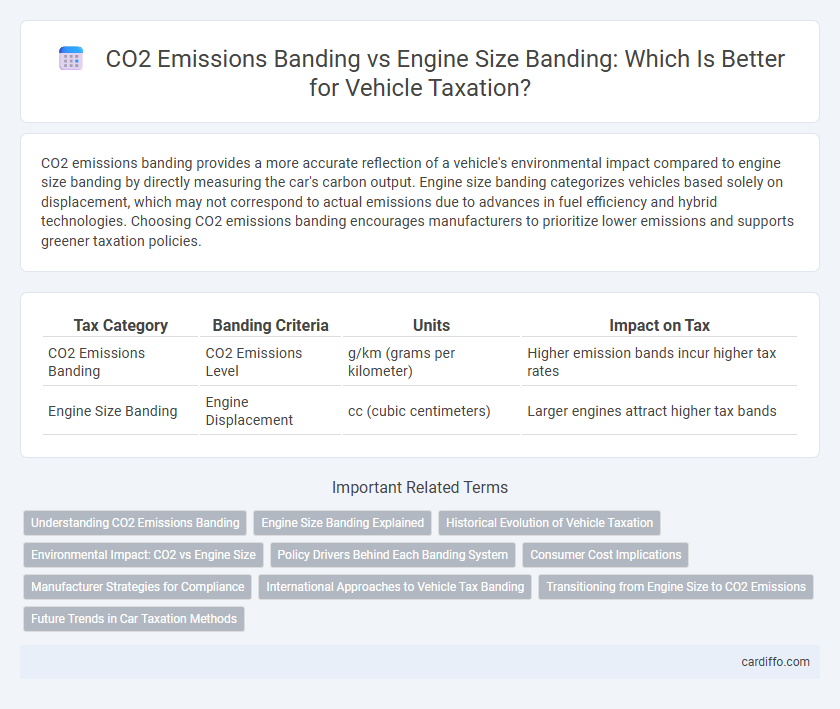CO2 emissions banding provides a more accurate reflection of a vehicle's environmental impact compared to engine size banding by directly measuring the car's carbon output. Engine size banding categorizes vehicles based solely on displacement, which may not correspond to actual emissions due to advances in fuel efficiency and hybrid technologies. Choosing CO2 emissions banding encourages manufacturers to prioritize lower emissions and supports greener taxation policies.
Table of Comparison
| Tax Category | Banding Criteria | Units | Impact on Tax |
|---|---|---|---|
| CO2 Emissions Banding | CO2 Emissions Level | g/km (grams per kilometer) | Higher emission bands incur higher tax rates |
| Engine Size Banding | Engine Displacement | cc (cubic centimeters) | Larger engines attract higher tax bands |
Understanding CO2 Emissions Banding
CO2 Emissions Banding categorizes vehicles based on their carbon dioxide output, providing a more accurate reflection of environmental impact compared to Engine Size Banding, which classifies vehicles solely by engine displacement. This method aligns tax rates with actual emissions, incentivizing lower-emission vehicles and promoting eco-friendly driving habits. By focusing on emissions rather than engine capacity, CO2 Emissions Banding supports regulatory goals to reduce greenhouse gas emissions and combat climate change.
Engine Size Banding Explained
Engine size banding for vehicle taxation categorizes cars based on their engine displacement, typically measured in cubic centimeters (cc), to determine tax rates. Larger engine sizes generally correspond to higher tax bands due to increased fuel consumption and emissions. This system simplifies tax calculations but may not accurately reflect a vehicle's environmental impact compared to CO2 emissions banding, which directly measures the car's carbon output.
Historical Evolution of Vehicle Taxation
Vehicle taxation has historically evolved from simple engine size banding, where larger engines incurred higher taxes due to fuel consumption, to CO2 emissions banding that targets environmental impact more precisely. This shift reflects regulatory efforts to reduce greenhouse gas emissions by linking tax rates directly to a vehicle's carbon output rather than just its engine displacement. The transition to CO2-based taxation aligns with global climate goals and incentivizes manufacturers to develop low-emission vehicles.
Environmental Impact: CO2 vs Engine Size
CO2 emissions banding directly reflects the environmental impact of a vehicle by measuring actual carbon dioxide output, incentivizing reductions in greenhouse gases. In contrast, engine size banding categorizes vehicles based on engine displacement, which may not accurately correlate with real-world emissions due to varying technologies and efficiencies. Prioritizing CO2 emissions bands ensures tax policies better align with climate goals by targeting vehicles that contribute most to carbon pollution.
Policy Drivers Behind Each Banding System
CO2 emissions banding is driven by environmental policies targeting reductions in greenhouse gas emissions through stricter vehicle emission standards, reflecting commitments to climate change mitigation goals. Engine size banding, however, is primarily influenced by traditional taxation frameworks that categorize vehicles based on engine displacement to tax fuel consumption and road wear. Shifts toward CO2 emissions banding represent a policy evolution prioritizing ecological impact over engine capacity, aligning taxation with sustainable mobility objectives.
Consumer Cost Implications
CO2 emissions banding typically results in more precise tax charges reflecting a vehicle's environmental impact, often leading to higher consumer costs for cars with larger emissions. Engine size banding, based on cubic capacity, can lead to less accurate taxation, sometimes favoring larger engines with lower emissions, thus affecting consumer expenses differently. Understanding the distinction between these approaches is essential for consumers aiming to minimize their tax burden while considering vehicle efficiency and environmental regulations.
Manufacturer Strategies for Compliance
Manufacturers strategically optimize vehicle portfolios by balancing CO2 emissions banding with engine size banding to meet regulatory compliance while minimizing tax liabilities. Implementing advanced technologies in smaller engines reduces emissions, enabling better positioning within favorable CO2 emissions bands. This dual approach supports compliance with environmental standards and enhances market competitiveness through tax-efficient product offerings.
International Approaches to Vehicle Tax Banding
International approaches to vehicle tax banding vary significantly, with many countries adopting CO2 emissions banding to incentivize lower environmental impact and align with climate goals. Engine size banding, based on engine displacement, remains prevalent in some regions but is increasingly being supplemented or replaced by emissions-based metrics to reflect real environmental costs accurately. Emissions-based taxation provides a more precise mechanism for reducing carbon footprints, influencing manufacturers and consumers towards greener vehicle choices globally.
Transitioning from Engine Size to CO2 Emissions
Transitioning from engine size banding to CO2 emissions banding aligns vehicle taxation with environmental impact, promoting cleaner technologies and reducing carbon footprints. CO2 emissions banding offers a more accurate measure of a vehicle's environmental cost by directly reflecting its greenhouse gas output, unlike engine size which serves as an indirect and less precise indicator. This shift incentivizes manufacturers to develop low-emission vehicles and supports policy goals aimed at achieving national climate targets.
Future Trends in Car Taxation Methods
Future car taxation methods are increasingly shifting from engine size banding toward CO2 emissions banding to reflect environmental impact more accurately. CO2 emissions banding incentivizes manufacturers and consumers to prioritize low-emission vehicles, aligning with global climate targets and reducing carbon footprints. This trend supports stricter regulatory frameworks and promotes advancements in electric and hybrid vehicle adoption, signaling a move toward sustainable transportation taxation.
CO2 Emissions Banding vs Engine Size Banding Infographic

 cardiffo.com
cardiffo.com